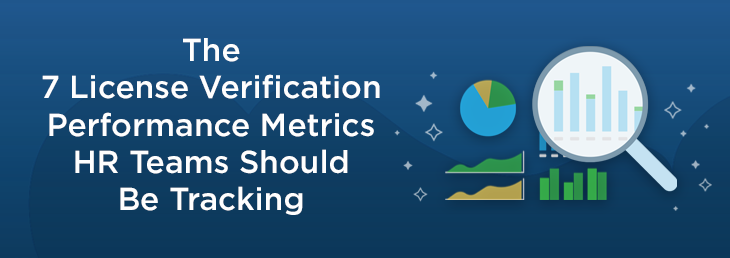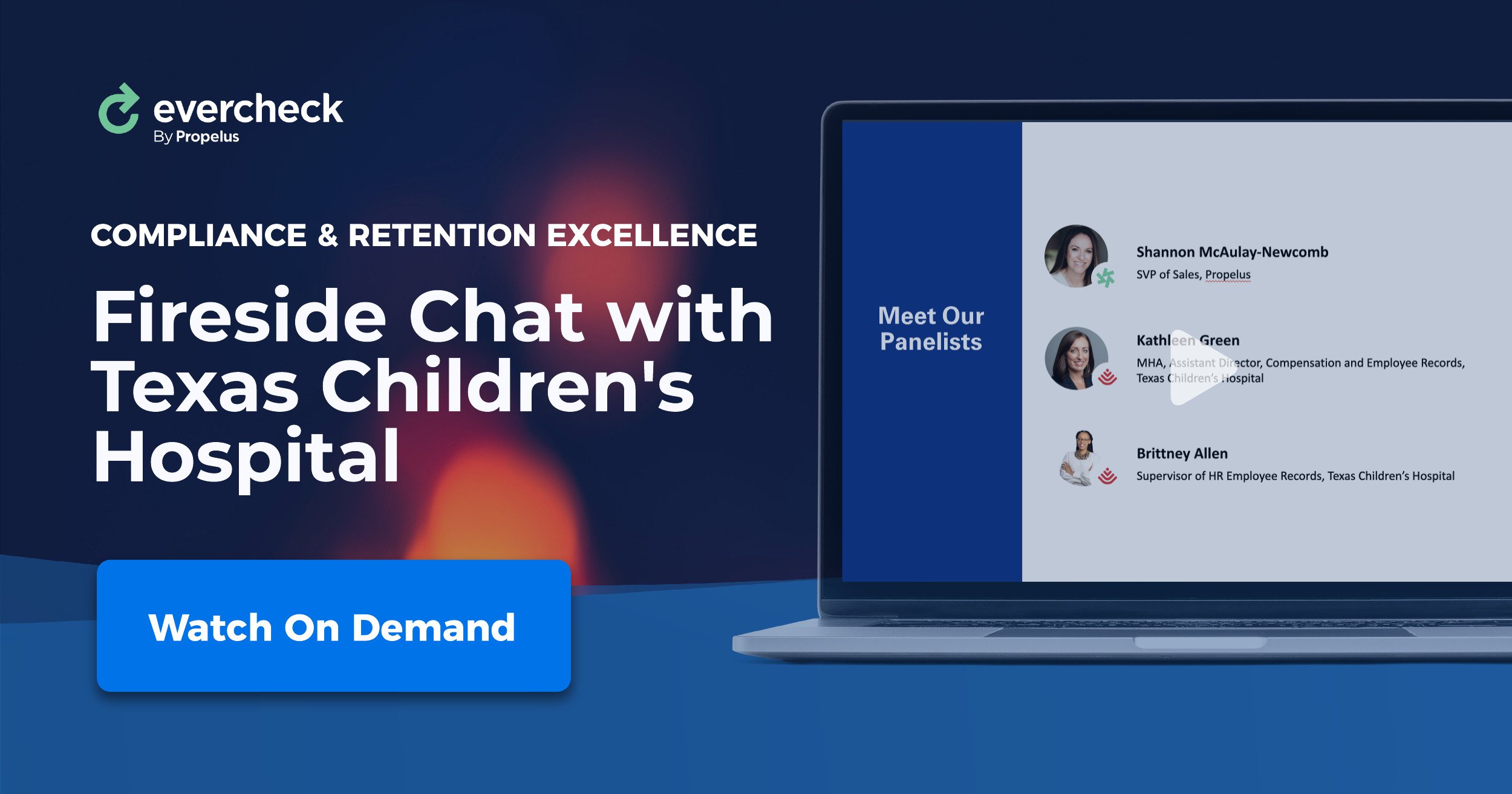
Would you call your license verification program a success? A proactive process rather than a reactive one?
License verification is a fairly straight-forward process, right? Those who provide patient care must be licensed properly to do so, period. But beyond the surface, there’s a nuance that deserves a hard look. How your process performs in terms of both effectiveness and efficiency sheds light on how you’ll fare during a regulatory survey and the types and amounts of resources your process requires.
Whether your organization handles license verification in-house or works with a Credentials Verification Organization (CVO), there are key metrics that you and your team should be used to evaluate the effectiveness and compliance of your program. Let’s take a look.
Effectiveness metrics
These are the metrics by which you should evaluate whether your organization is remaining compliant with the regulatory standards of your governing body.
1. How long it takes your team to identify and respond to critical changes in license status?
By critical, we mean the types of changes that may render a candidate or employee ineligible to provide patient care - disciplinary sanctions, exclusions, elapsed or revoked licensure, etc. Caregivers must be properly licensed to provide patient care at all times. Although the regulatory standard is to verify at hire and at renewal, this leaves critical gaps, sometimes years, where these changes may go undetected. By the time your team recognizes the changes, the caregiver may have been unlawfully providing patient care for some time, rendering your organization out of compliance.
A best practice approach is verifying licensure every day, if possible, or at least once monthly. This reduces the time it takes your team to identify and take action on  important licensure changes. How long does it take your team to identify these changes? Are you satisfied with this performance? If not, it may be time to consider increasing how often you verify.
important licensure changes. How long does it take your team to identify these changes? Are you satisfied with this performance? If not, it may be time to consider increasing how often you verify.
2. What percentage of your licensed population renews on time?
Late license renewals have a number of consequences - disruptions in the work schedule, administrative resources to follow up and reschedule patients, and more. The goal, of course, is for your population to renew on or before the license expiration date 100% of the time; however, well, all know that we don’t live in a perfect world, and there are always a few stragglers. ![]()
If more than 1% of your population isn’t renewing on time, it’s possible to move the needle in a better direction. Some professional licensure boards provide their own renewal reminders and resources to licensees, but your team can supplement these reminders with your own. We recommend sending email reminders to caregivers at 60, 30, 15, 10, 5, 3, 2, and 1 days prior to the license expiration date or until your team is able to confirm renewal. This frequency and proximity to the deadline allow plenty of time for caregivers to complete any continuing education credits required and for the renewal to be submitted and processed. If this frequency seems taxing on your team’s resources, ask your CVO provider whether renewal reminder automation is a service they’re able to provide.
3. How long it takes to find, retrieve, and present proof of verifications during a regulatory survey?
During a survey, you should expect and be prepared to provide proof of verification compliance to your surveyor. You do not want to be caught scrambling to provide proof of a particular verification or unable to provide proof at all. A paper trail of verifications loses its effectiveness in proving compliance if you’re unable to quickly find and submit them during your survey. If you’re taking more than 2-3 minutes to locate and retrieve any verification, you’re taking too long. Keeping verifications securely and digitally stored is the best practice approach in your HR system or your CVO’s system (or both). Be sure to receive proper training in how to retrieve verifications from the system.
Efficiency metrics
Where effectiveness determines how well your organization complies with regulatory standards, efficiency determines how you might lose money on the process. Because, after all, time is money.
1. The number of full-time employees dedicated to licensing verification for your organization; or the number of hours any employee dedicates to the task.
![]() Once you are able to determine the number of hours your staff spends on license verification, you’re one step closer to determining how much the process is costing. This is crucial in determining budgeting requirements and planning for additional staff resources in the future.
Once you are able to determine the number of hours your staff spends on license verification, you’re one step closer to determining how much the process is costing. This is crucial in determining budgeting requirements and planning for additional staff resources in the future.
It’s also important to calculate opportunity costs. It’s uncommon for one or more staff to be dedicated to licensing verification; often, this person’s or people’s time is distributed between verification and other important tasks. The more time an individual spends verifying licensure and its accompanying tasks, the less time they’re able to spend on other important and meaningful initiatives for the organization - an opportunity cost. If you find that your team is spending more time than necessary on license verification, consider researching alternatives such as outsourcing the verifications to a third-party CVO or automation (or both - some CVOs offer automation as their core service).
2. How many steps are required to collect, review, and verify licensure for candidates and employees?
The more steps there are, the more the process becomes prone to error. Complexity is counterproductive and inefficient, and anyone who’s ever been responsible for license verification knows that the process is much more involved than the verification itself. It actually requires things like identifying which licenses are coming due for renewal, sending email notifications to staff and managers, verifying the license, tracking who has and has not renewed and preparing teams for staffing shortages, among other various administrative efforts.
Take an inventory of how many steps your process has from start to finish. Perhaps you even have the process written down already. If you have more than 4-5 steps, it’s time to simplify. Try re-writing the process from scratch without the influence of the current steps. Then, evaluate where to trim some of the fat. Where are the redundancies, and are they necessary? Critically analyzing your process can help you identify where to make changes. If you’re vetting vendors, it’s also wise to see a detailed outline of their processes so you can compare and contrast.
3. Your turnaround time for collecting and verifying licensure from candidates and employees.
HR and recruitment teams should be able to identify the amount of time it takes to collect, verify, and confirm license requirements from candidates. The same can be said for collecting renewal information from employees. Candidates and employees should have a clear picture of the expectation of their responsibilities in this process. If you find that collecting and verifying is taking weeks, requires an unreasonable amount of email/phone correspondence, or results in frustration from either party, it’s time to rethink the process.
The organization is key in reducing this metric - having a clear and accurate set of requirements for each position, a streamlined process for candidates to submit requirements and employees to submit renewals, an efficient or automated way to verify the licenses as they’re submitted, and a reliable process to keep track of employee renewals. Shore up your internal processes or look to outside help, such as a CVO specializing in pre-boarding and license renewals, to streamline the process.
4. The number of processing errors that occur as a result of manual review.
Where there’s a manual process, there are processing errors. After all, to err is human. The goal is not only to mitigate the implications of these errors but to reduce or eliminate them altogether. Errors include, but aren’t limited to, things like inputting the wrong license number or expiration date into your system of record.
Organizations usually employ a system of checks and balances, like data audits, to mitigate these errors, but they require considerable staff resources, which isn’t efficient. Automation is the best practice approach to addressing manual errors because the technology is designed to identify errors automatically. Automation removes the step of identifying the errors and leaves teams with actionable and reasonable to-do’s, like updating information within the HRIS.

—
As with any process, the idea is to get ahead of license verification rather than become reactionary as a result of it. Transparent efficiency and effectiveness metrics are the first steps in simplifying the process; the next is to take this data and use it as actionable insights. The absolute best practice approach in fortifying your license verification process and optimizing your team’s performance is automation. If you find that your numbers are less than ideal, it may be time to begin the process of finding a better way. Be sure to include automation as one option.
If you’re interested in learning more about how automation can streamline and simplify not only license verification but the additional tasks like renewal reminders and HRIS updates, let’s talk. EverCheck has helped more than 300 hospitals throughout the nation set a higher standard for verification. Our mission is to make healthcare work better. Schedule your consultation to see if we can do the same for your organization.



